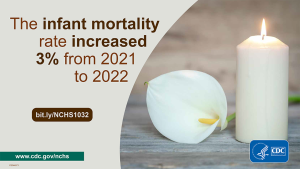Infant Mortality Rate Sees First Rise in 20 Years
Posted on by A new Vital Statistics Rapid Release report from the National Center for Health Statistics shows that the provisional infant mortality rate for the United States in 2022 rose 3% from 2021, the first year-to-year increase in the rate since 2001 to 2002. From 2002 to 2021 the infant mortality rate declined 22%.
A new Vital Statistics Rapid Release report from the National Center for Health Statistics shows that the provisional infant mortality rate for the United States in 2022 rose 3% from 2021, the first year-to-year increase in the rate since 2001 to 2002. From 2002 to 2021 the infant mortality rate declined 22%.
Detailed findings in the report, “Infant Mortality in United States: Provisional Data from the 2022 Period Linked Birth/Infant Death File” include:
- The provisional infant mortality rate for the United States in 2022 was 5.60 infant deaths per 1,000 live births (that rate was 5.44 in 2021).
- The total number of infant deaths for 2022 was 20,538. This was a 3% increase over 2021 which had 19,928 infant deaths.
- From 2021 to 2022, increases in mortality rates were observed in the following categories:
- Neonatal and postneonatal infant deaths: The neonatal mortality rate increased 3% from 3.49 to 3.58 and the postneonatal mortality rate by 4%, from 1.95 to 2.02
- Infants born to American Indian and Alaska Native and White women: Mortality rates increased significantly among infants of American Indian and Alaska Native, non-Hispanic (7.46 to 9.06) and White, non-Hispanic women (4.36 to 4.52).
- Infants born to women ages 25 to 29: Infant mortality rates increased significantly for infants of women ages 25-29 from 5.15 to 5.37.
- Infants born preterm: Mortality rates increased significantly for total preterm (less than 37 weeks of gestation) and early preterm (less than 34 weeks of gestation) infants.
- Male infants: The mortality rate increased significantly for male infants from 5.83 infant deaths per 1,000 live births to 6.06.
- Infants in four states: Infant mortality rates increased in Georgia, Iowa, Missouri, and Texas.
- In two of the 10 leading causes of death: Mortality rates increased in cases of maternal complications and bacterial sepsis.
This is the first report to present provisional data on infant mortality rates by selected maternal and infant health characteristics for the United States based on the linked birth/infant death file. Previous reports used only final data. For the linked birth/infant death data, birth certificates and death certificates are linked to provide additional information only available from the birth certificate, such as maternal age, gestational age, and a number of pregnancy, labor and delivery, and infant characteristics.
This analysis uses all linked birth/infant death records received and processed by National Center for Health Statistics for calendar year 2022 as of July 27, 2023. Data from birth certificates and death certificates are collected via the National Vital Statistics System.
Posted on by

